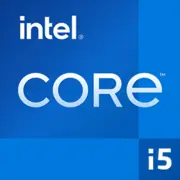Intel Core i5-11600KF

Intel Core i5-11600KF: Review and Build Recommendations for 2025
The last fight of 14 nm: Is it worth getting the "veteran" Rocket Lake today?
Key Specifications: Architecture and Performance
The Intel Core i5-11600KF, released in 2021, is part of the Rocket Lake lineup—the final generation of Intel's 14 nm process. Despite its age, it remains relevant for budget builds in 2025 due to its favorable combination of price and performance.
- Architecture: 6 cores (12 threads) with a base frequency of 3.9 GHz and turbo mode up to 4.9 GHz.
- Cache: 12 MB L3 — sufficient for gaming and most work tasks.
- Technologies: Supports PCIe 4.0 (20 lanes), lacks integrated graphics (indicated by the "F"), and has an unlocked multiplier for overclocking.
- Performance: In Geekbench 6 tests (2258/9291), the processor shows performance comparable to the Ryzen 5 5600X but lags behind newer hybrid CPUs like the Core i5-13600K.
Key Features:
- Overclocking potential up to 5.1–5.2 GHz on air cooling (as reported by overclockers).
- Support for Resizable BAR to increase FPS in games (Nvidia RTX 3000/4000, AMD RX 6000/7000).
Compatible Motherboards: LGA 1200 Socket and Chipsets
The i5-11600KF is compatible with LGA 1200 socket motherboards with 500 series chipsets:
- Z590: The best choice for overclocking (e.g., ASUS ROG Strix Z590-E, $180–250). Supports PCIe 4.0 and memory XMP profiles.
- B560: Budget option with limited overclocking (MSI B560 Tomahawk, $120–150).
- H510: For office PCs — minimal ports and features (Gigabyte H510M-H, $80–100).
Important: When choosing a motherboard, check for PCIe 4.0 support — not all H510/B560 models enable it for SSDs.
Memory: DDR4 and Limitations
The processor only works with DDR4:
- Recommended Modules: 2×8 GB DDR4-3200/3600 MHz (e.g., Corsair Vengeance LPX).
- Maximum Capacity: 128 GB (but 16–32 GB is sufficient for gaming).
Limitation: The lack of DDR5 support makes future system upgrades challenging — both the CPU and the motherboard will need to be replaced.
Power Supply: How Many Watts Are Needed?
With a TDP of 125 W and overclocking, power consumption can reach 150–170 W. Recommendations:
- Without a discrete graphics card: 450 W, but this is pointless for the i5-11600KF (there’s no integrated graphics).
- With a GPU like RTX 4060/RX 7600 XT: 650 W (Corsair RM650x, Seasonic Focus GX-650).
- For high-end cards (RTX 4080): 750–850 W, but such a pairing would create a "bottleneck" — the CPU won't fully leverage the GPU's potential.
Tip: Choose PSU units with an 80 Plus Gold certification and a 7-10 year warranty.
Pros and Cons of the i5-11600KF in 2025
Pros:
- Price: New processors are still available for $180–200.
- Gaming Performance: 60+ FPS in Cyberpunk 2077 (1080p, Ultra) with an RTX 3060 Ti.
- Overclocking Potential: Even on air, you can squeeze out +10–15% performance.
Cons:
- Energy Efficiency: 14 nm vs. 5–7 nm in competitors — higher heating and electricity bills.
- Dead Platform: No upgrades without replacing the motherboard.
Use Case Scenarios
- Gaming: Ideal for Full HD/1440p with a mid-range graphics card (RTX 4060). Struggles at 4K due to GPU limitations.
- Work Tasks: Quick rendering in Blender, 4K editing in Premiere Pro (but 6 cores fall behind 12-core Ryzen 9).
- Streaming: NVENC on the GPU performs better than CPU encoding.
Example: For streaming Dota 2 (1080p@60) + OBS, 16 GB of RAM and an RTX 3060 are sufficient.
Comparison with Competitors
- AMD Ryzen 5 5600X ($190): Similar price, but lower peak frequency (4.6 GHz). Offers PCIe 4.0 support and better energy efficiency.
- Intel Core i5-12600K ($230): 10 cores (6P+4E), DDR5, but requires more expensive LGA 1700 motherboards.
- Ryzen 5 7600 ($220): AM5, DDR5, but the platform is pricier.
Conclusion: The i5-11600KF is a good value if you already have LGA 1200 or want to save money.
Practical Build Tips
1. Cooling: A cooler like the DeepCool AK620 ($60) or Arctic Liquid Freezer II 240 ($90) for overclocking.
2. Case: At least 2 fans (e.g., NZXT H510 Flow).
3. SSD: Make sure it’s PCIe 4.0 (WD Black SN850X) to unleash the potential.
4. Budget Build:
- Motherboard: ASUS Prime B560-Plus ($130).
- Memory: TeamGroup T-Force Vulcan Z 16 GB DDR4-3600 ($55).
- PSU: EVGA 650 BQ ($80).
Final Thoughts: Who is the i5-11600KF Suitable For?
This processor is a solid choice if:
- You are upgrading an old PC on LGA 1200 and don’t want to change the motherboard.
- You need a budget gaming CPU for Full HD/1440p without paying extra for DDR5.
- You're an overclocking enthusiast willing to manage heat for additional megahertz.
Alternative: If you’re building a system from scratch, it’s better to go for the Ryzen 5 7600 or Core i5-13400F — they offer more modern technology and future-proofing.
In 2025, the i5-11600KF is a "workhorse" for those who value a balance of price and performance but are ready to contend with the compromises of an outdated platform.
Basic
CPU Specifications
Memory Specifications
GPU Specifications
Miscellaneous
Benchmarks
Compared to Other CPU
Share in social media
Or Link To Us
<a href="https://cputronic.com/en/cpu/intel-core-i5-11600kf" target="_blank">Intel Core i5-11600KF</a>